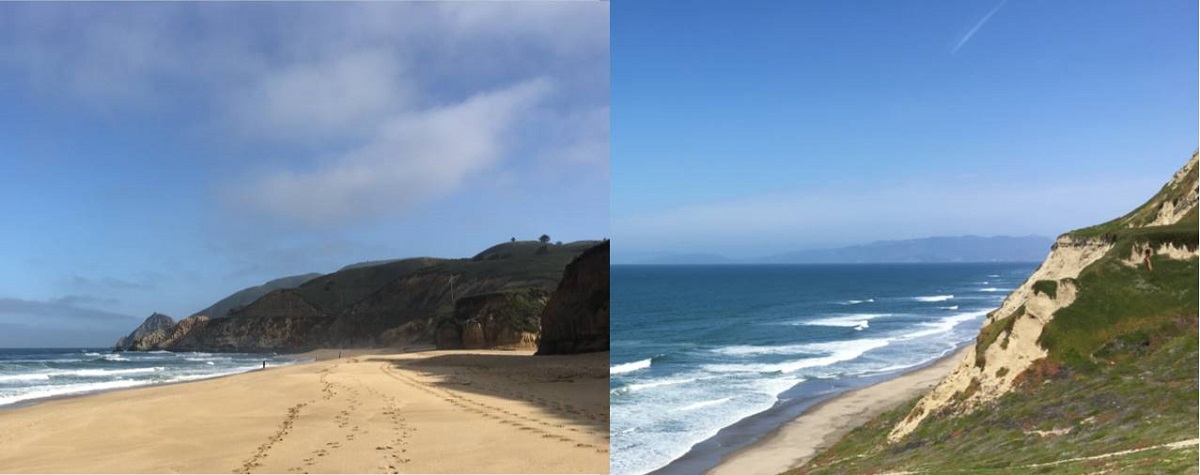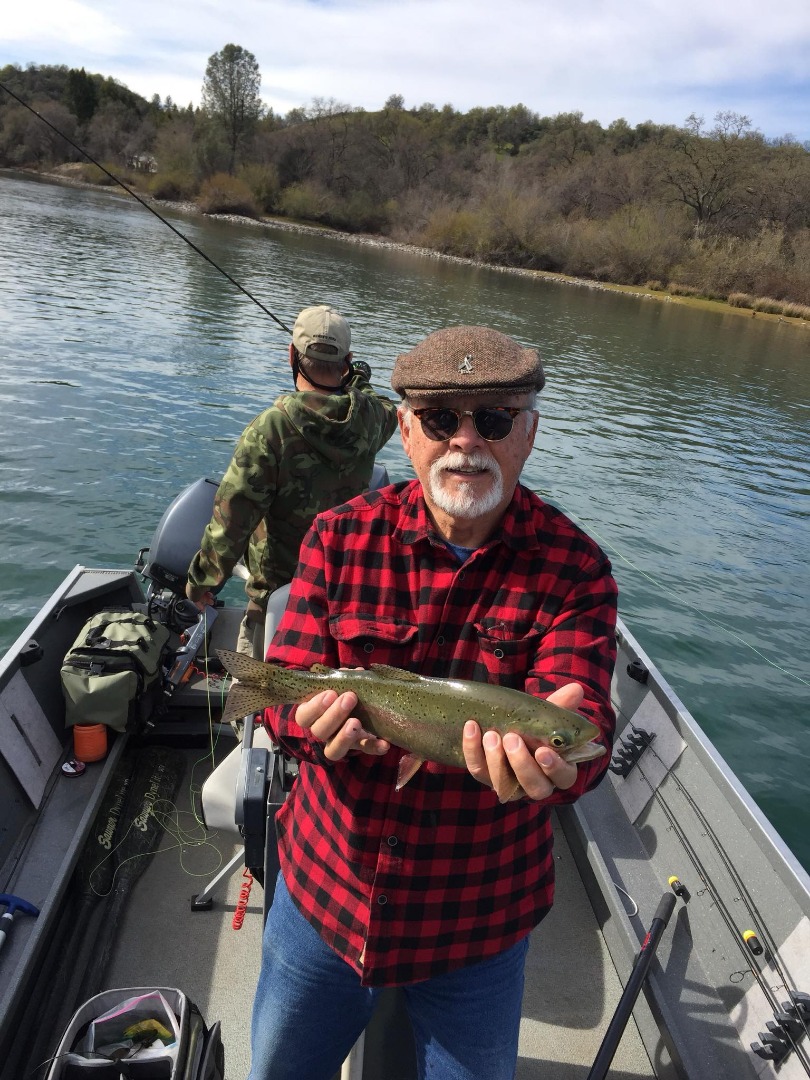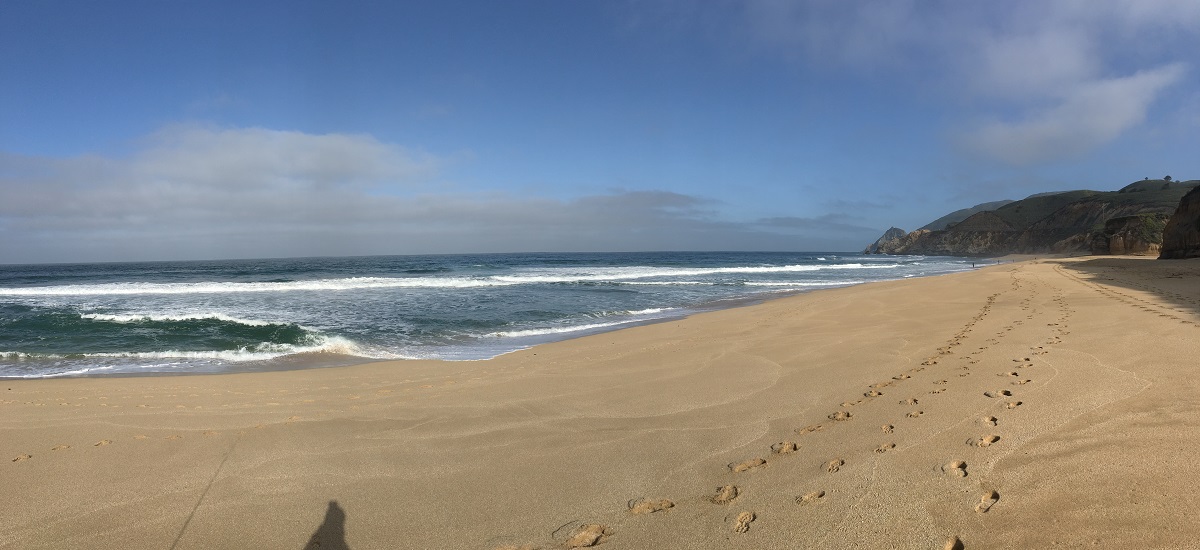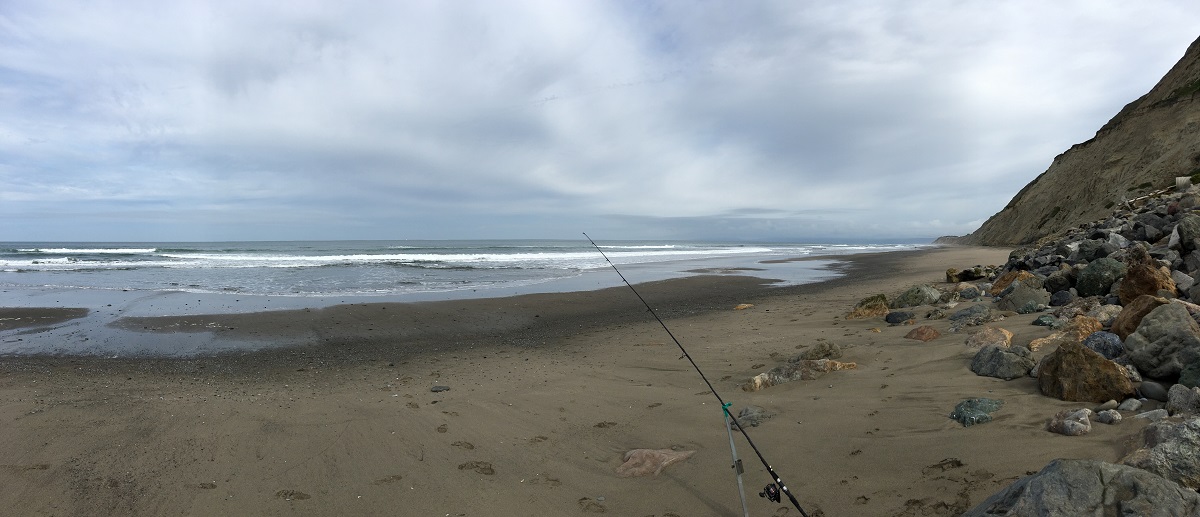A Tale of Two Beaches

by Jerry Back
4-8-2018
Website
It was the best of beaches; it was the worst of beaches--uh, this isn’t going to work as both beaches were awesome in their own way. I fortunately was able to fish twice this week and had decided to branch out from my usual Ocean Beach. There are a ton of beaches in the Bay area that I’ve yet to fish and so I could pretty much go anywhere and find virgin territory.
My first day out was at Montara State Beach. I’ve occasionally driven past this stretch of picturesque shoreline on my way to Half Moon Bay and wondered what it would be like to fish it. The sand here is more like what you’d find in Hawai’i than what you get at Ocean Beach just 15 miles to the north. I parked in the north side parking lot, but be warned that to get down to the beach, one has to make use of a rope since the lower part of the staircase seems to have been washed away--probably during last year’s major rainstorms. It’s not easy on the knees, so if you’re not up for it, try the parking lot on the south side of the beach where the approach to the beach looks more gentle.
Montara is a steep-sloping beach, which makes it fairly easy to cast out to the first set of waves (unlike Ocean Beach, which is very flat and the first waves break sometimes 100 to 200 yards off shore). That said, one should be very careful on the shoreline because if you get knocked down by a wave, you could find yourself in deep water and pulled out to sea quickly. I basically don’t even let the water get past my ankles here, so use great care when getting close to the water.
I was excited to try the Z-Man Crusteaz bait again after a strong performance last month at Ocean Beach. This time, I hooked the Crusteaz from nose-tip through and out its midsection like I would a Gulp! Sandworm (instead of using a sewing needle to thread the leader line straight through the entire body). This is easier and faster than using the needle, but the Crusteaz can now be pulled halfway off the hook, which means I have to occasionally reposition it after repeated hits to it by the perch.
The peak low tide had been at 7:30 AM earlier in the morning, and I started fishing around 9:30 AM, which I thought would be optimal. I try to fish the rising tide about three hours before the peak high tide for better, more consistent results. Once the bait hit the water, I almost immediately started catching perch. The fish were small-ish, though, and quickly tossed back.
After reeling in a few perch with the Crusteaz, I figured it was safe to try this new Z-Man bait I had recently bought that is made of the same durable “ElaZtech” material. This bait is the Z-Man Finesse ShadZ in the smelt color. I thought it would be worth experimenting with the Finesse ShadZ if I knew the fish were already biting on the Gulp! Camouflage sandworm or Z-Man Crusteaz. To me, it’s a bait that I think a striper would consider chomping on.
I hooked it onto my #2 baitholder hook like you would see the hook on a swimbait with its hook point, barb and bend poking out of the bait’s back. I did catch a couple of perch using this bait, but it’s 4” long and until the fish really tries gobble it up, the perch mostly just tug at the tail end. I went back to the Crusteaz for more consistent hookups and eventually got a small 12” striper (tossed immediately back, of course--the legal size for striped bass is 18” or greater).
The morning bite was so good. I even let two random young kids (around 8 and 10 years-old) who were passing by with their families reel in fish after I got the hook set. They had a blast reeling in what probably was their first fish (note: in California, it is legal for a child under 16 to fish without a license) and, hopefully, left the beach with a lifetime memory.
All in all, I ended up catching 12 perch and one striper by 12 noon at Montara State Beach. I kept for my Mom-in-Law the three largest perch (one 12” fish and two 11” fish). I should have quit then, though, as the bite just completely turned off afterwards. I’d get some small hits, but no hookups once we started getting close to high tide.
The next day after my outing at Montara State Beach, I didn’t fish, but instead went hiking around the Daly City coastline. I wanted to check out Daisaku Ikeda Canyon and walk down to nearby Thornton State Beach, which is a long stretch of beach below towering 500+ foot cliffs. This is real exercise--especially on the hike back up to the street where you park your car. Unless you’re in reasonably good shape, this isn’t the hike for you.
After reaching the beach, I eventually came across and talked with a fisherman who was fishing for both perch and striper using a fish-finder rig and baiting it with soft-shell sand crab. He must have done well and I could see a striper tail sticking out of his bucket. I decided that I’d come back the next day with rod and reel and try to find some productive fishing along this long stretch of isolated beach.
So the next day after I make it down the long trek through the canyon to the beach, I don’t see anyone else except for a lone fisherman heading home and who told me he had just spent a couple of fruitless hours fishing the very bottom of the low tide. I decided to walk down the beach a bit. There is no one out here at all--probably because it’s not easy to get down here and also because there’s not much water yet as it was still close to low tide.
Low tide is actually a great time to be at the beach as one can more easily spot the rip currents and outflows indicative of underwater structures that aren’t easy to spot once the tide starts coming in. Find the structure and you have a better chance at finding fish.
I find a promising spot and begin to fish. Again, not much water so I didn’t start to get consistent hits until almost noon. Once there was enough water and rising tide, I began to catch some small-ish perch. By this time, I was joined nearby by a couple of fishermen using fish-finder rigs and who spent most of the time looking for the perfect soft shell sand crab. It’s a skill I’ve yet to acquire and I know this approach can yield some amazing stripers. For now, I like the cast and retrieve of the Carolina rig and actually holding the rod in my hand so as to feel the actual moment when the fish strike at the bait.
My plan was to first catch a few perch using the Crusteaz and Gulp! camouflage sandworm just so that I couldn’t be skunked for the day. After that, I would then switch to bucktails, Kastmasters, mickeys, and even a popper lure so that I could see if any stripers were in the area. As I was fishing for perch with my Carolina rig and sandworm, I hooked up with what I thought was a sizable perch, but actually turned out to be a 14” striper. That was great, because if a small striper could be keyed into biting a Gulp! sandworm, perhaps a legal-sized one could do so, as well.
I decided to keep with the sandworm and not long after I was rewarded with a 19” striper. I quickly measure the fish to make sure it was legal and get it into the fish bag (where I keep a couple of small bags of ice). I then return to the water since there might be a second striper out there to catch. Normally after catching a striper, I usually just pack up and head home since my family doesn’t need two of these fish, but I thought I’d keep at it a while longer just to see what would happen. Nothing else happened other than I caught a couple of more perch. Still, any day when a striper is on your line is definitely a good day.
To cap off the day, I got to talk with a lone fisherwoman who arrived mid-afternoon and was fishing nearby with basically the same Carolina rig/Gulp! Sandworm set-up I was using. She had caught a couple of perch in the short time she had been there and I left her alone on the beach with the hope that catching a striper was a very real possibility for her since I had done that just about an hour earlier. As I hiked back up the canyon, I took one last look back down to the beach and could see her still casting. I hope she caught one!
So, I think the stripers are beginning to show up along the coast, but we probably still have a ways to go before the season starts to heat up in late-spring and early-summer. I’m definitely encouraged though, since I still consider myself an avid learner in the pursuit of striped bass. It’s great to have fish in the water because it validates the techniques and observations you’re making on the sand. If there are no fish, it doesn’t matter how good a fisherman you are. And when there are fish, you now have the chance to have your skills tested and, hopefully, get rewarded. Now’s the time to build up some skills and test some new approaches before the real wave of stripers return and the beaches get crowded with fishermen.
Jerry Back is a television research executive residing in San Francisco, California. Other outdoor interests include fishing for Striped Bass (a.k.a., “stripers”) and anything else he can catch on the beaches of San Francisco. Jerry can be contacted at jerry.back@gmail.com.
Jerry also wrote an article for MyOutdoor Buddy titled "How to Catch Dungeness Crab with Rod and Reel," which can be found here. An archive of his recent articles published on NorCal.Fishreports.com can be found here.
Photos
More Reports

4-4-2018
It is at least a weekly occurrence when a vehicle owner, during the course of getting an Insurance collision estimate,...... Read More
What are the Odds?
Sacramento River - Lower
3-29-2018
This is one of those “It's a small world” and “you just never know” kind of a fishing story. One...... Read More














